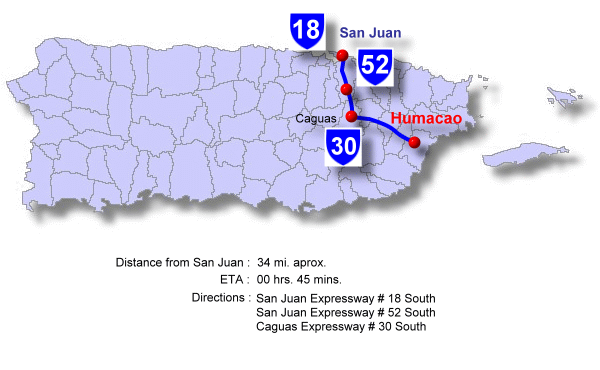
Humacao, Puerto Rico
Pearl of The Oriente
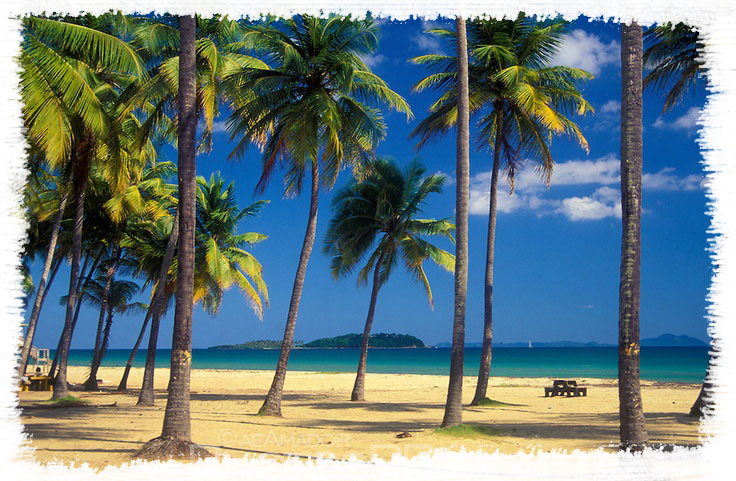 Humacao (oo-mah-KOU) known as “The Pearl of the East,” “The Gray City,” and “Los Roye Huesos,” is one of the most representative municipalities in eastern Puerto Rico. Its patron saint is the Immaculate Conception, and its main parish is dedicated to the Sweet Name of Jesus, reflecting the strong religious and cultural traditions of its community.
Humacao (oo-mah-KOU) known as “The Pearl of the East,” “The Gray City,” and “Los Roye Huesos,” is one of the most representative municipalities in eastern Puerto Rico. Its patron saint is the Immaculate Conception, and its main parish is dedicated to the Sweet Name of Jesus, reflecting the strong religious and cultural traditions of its community.
Located on the eastern coast of the island, Humacao is part of the Eastern Coastal Valleys, a fertile region with alluvial lands ideal for agriculture. It borders Naguabo to the north, Yabucoa to the south, the Vieques Passage and the Atlantic Ocean to the east, and Las Piedras to the west. Historically, the lowlands and coastal areas were used for the cultivation of coconuts and other minor crops, although in recent decades agriculture has given way to tourism and residential development.
The municipality stands out for its natural wealth and ecological value, particularly the Humacao Pterocarpus Forest, declared a Nature Reserve in 1986, which protects the largest freshwater wetland and mangrove ecosystem in eastern Puerto Rico. Its beaches and coastal reserves also promote ecological and recreational tourism.
Among the most important tourist attractions is Palmas del Mar, a world-class tourist and residential complex featuring resorts, golf courses, a marina, restaurants, and private beaches, attracting both local and international visitors. Likewise, the Punta Santiago neighborhood is notable for its beach, vacation center, and gastronomic offerings, as well as being the access point to Cayo Santiago, famous for its colony of rhesus monkeys used in scientific research.
Humacao is also an educational and cultural hub, hosting the Humacao Campus of the University of Puerto Rico, promoting academic, scientific, and technological development in the eastern region of the island.
Economically, the municipality maintains a diversified structure, including manufacturing (electronics, chemicals, pharmaceuticals, scientific instruments, electrical equipment, and clothing), commerce, construction, small-scale agriculture, livestock, and artisanal fishing. Tourism and services have also grown significantly thanks to the natural beauty of the coastline and the expansion of residential and tourist complexes.
Overall, Humacao combines indigenous history, agricultural tradition, and industrial modernity, establishing itself as one of the most dynamic cities with the highest potential for sustainable development in eastern Puerto Rico.
Foundation of Humacao
Before the arrival of European colonizers, the territory of Humacao was governed by the Taíno chief Jumacao, who had his yucayeque (indigenous settlement) along the Humacao River near the coast. Jumacao is recognized not only for his leadership but also for being the first Taíno chief to read and write in Spanish, demonstrating his ability to interact with the colonizers and defend the rights of his people.
It is known that Jumacao wrote a letter to the King of Spain denouncing that the Governor of the island was not complying with the agreements of a peace treaty and that he and other chiefs were virtually prisoners under the colonial regime. In his letter, Jumacao declared himself a free man, responsible for his own actions. The letter moved the Spanish monarch, who ordered the Governor to respect the terms of the treaty, highlighting the chief’s influence and firmness in defending his community.
The municipality of Humacao was officially founded around 1793. In 1881, it was granted the title of Villa, and in 1893 it received city status, reflecting its population and economic growth. According to tradition, many of its founders came from the Canary Islands, as was common in several towns in eastern Puerto Rico, contributing to the cultural and architectural diversity of the region.
Thus, Humacao preserves a unique historical heritage, combining Taíno indigenous memory, Spanish influence, and the cultural identity developed over more than two centuries.
Location:
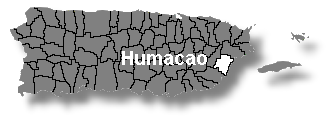 Humacao is located on the eastern coast of Puerto Rico, within the region of the Eastern Coastal Valleys. It borders Naguabo to the north, Yabucoa to the south, the Atlantic Ocean and the Vieques Passage to the east, and Las Piedras to the west. This strategic location combines access to the sea, fertile valleys, and proximity to urban centers, which benefits agriculture, tourism, and economic development.
Humacao is located on the eastern coast of Puerto Rico, within the region of the Eastern Coastal Valleys. It borders Naguabo to the north, Yabucoa to the south, the Atlantic Ocean and the Vieques Passage to the east, and Las Piedras to the west. This strategic location combines access to the sea, fertile valleys, and proximity to urban centers, which benefits agriculture, tourism, and economic development.
Area:
17 km² (45 square miles)
Population:
50,896 (2020 Census)
Population Density:
Approximately 496 inhabitants per km² (1,285 per square mile)
People are known as:
Humacaeños
Humacao is also known as:
The Pearl of the East
The Gray City
Los Roye Huesos
Neighborhoods (Barrios): Humacao, Puerto Rico
Humacao is divided into several barrios, each with its own unique characteristics and population distribution.

| Census 2020: Population by Barrios – Humacao |
Estimated Population |
| Antón Ruíz | 3,770 |
| Buena Vista | 3,718 |
| Candelero Abajo | 3,365 |
| Candelero Arriba | 3,747 |
| Cataño | 2,508 |
| Collores | 2,653 |
| Humacao Pueblo | 4,787 |
| Mabú | 8,526 |
| Mambiche | 2,052 |
| Mariana | 3,237 |
| Punta Santiago | 5,524 |
| Río Abajo | 7,144 |
| Tejas | 8,004 |
| Total | 50,896 |
Source: Censo 2020
Patron:
The Immaculate Conception
Dulce Nombre de Jesús
P.O. Box 546
Humacao, Puerto Rico 00792
Phone: (787) 852-0868

Topography
Humacao is part of the Eastern Coastal Valleys region. Most of its territory is flat, lying below 100 meters (328 feet) above sea level, which makes it susceptible to flooding. In the southwest, there are minor elevations such as Cerro Candelero, while in the northwest, there are several small hills, including Mabú.
Hydrography
The municipality is crossed by the Antón Ruíz, Humacao, and Candelero rivers, as well as the Frontera, Cataño, Mariana, Del Inglés, and Del Obispo streams. All of these water bodies belong to the Eastern watershed or Vieques Passage watershed and are essential for agriculture, local biodiversity, and wetland conservation.
Predominant Industries
Humacao has a diversified economy that combines industry, agriculture, commerce, and tourism. Its main industries include:
- Manufacturing: Production of electronics, chemicals, pharmaceuticals, scientific instruments, electrical and electronic equipment, leather goods, and clothing.
- Agriculture: Cultivation of coffee, sugarcane, rice, tobacco, and minor fruits, as well as coconut production in coastal areas.
- Livestock and artisanal fishing: Continuing traditional activities of the region.
- Commerce and construction: Driven by urban and residential growth.
- Tourism and services: Boosted by Palmas del Mar, resorts, beaches, and cultural and ecological attractions.
Flag of Humacao
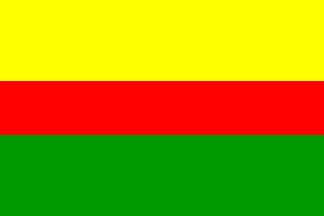 The flag of Humacao consists of three horizontal stripes, each carrying deep historical and cultural significance:
The flag of Humacao consists of three horizontal stripes, each carrying deep historical and cultural significance:
- Top yellow-gold stripe: Represents the crown of Cacique Jumacao, the Taíno leader who governed the territory before the arrival of the Spanish colonizers.
- Central red stripe: Symbolizes the small coat of arms of the municipality, reflecting Spanish heritage and local identity.
- Bottom green stripe: Refers to the arrows used by the Taínos, symbolizing the resistance and defense of their people.
The flag honors Jumacao, who was the first Taíno chief to read and write in Spanish. His literacy enabled him to write a letter to the King of Spain, denouncing that the Governor of Puerto Rico was not honoring the terms of a peace treaty and noting that he and other chiefs were virtually prisoners under the colonial regime. In the letter, Jumacao declared himself a free man responsible for his own actions. The letter moved the Spanish monarch, who ordered the Governor to comply with the treaty, solidifying Jumacao as a symbol of freedom, leadership, and Taíno resistance.
Coat of Arms
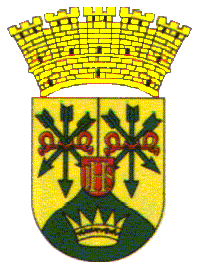 The coat of arms of Humacao reflects the municipality’s history, culture, and indigenous heritage. Its primary colors are gold and green, with symbolic elements that tell the story of the local identity:
The coat of arms of Humacao reflects the municipality’s history, culture, and indigenous heritage. Its primary colors are gold and green, with symbolic elements that tell the story of the local identity:
- Gold: Represents the color of the sun, symbolizing Humacao’s location in eastern Puerto Rico, where the sun rises.
- Green: Symbolizes Taíno heritage and the natural wealth of the valley where the city is located, highlighting the connection to the land and tropical vegetation.
The coat of arms also includes additional distinctive elements:
- Crown: Positioned at the top, derived from Spanish royal decrees, also symbolizing the leadership of Cacique Jumacao.
- Arrows: Represent the two wars Jumacao fought against the Spanish colonizers in the 16th century, commemorating his leadership and resistance.
- Small central shield: References the Catholic Church Dulce Nombre de Jesús, symbolizing Humacao’s faith and religious tradition.
The coat of arms was designed by Roberto Biascochea Lota in 1975 and officially adopted by the Municipal Assembly that same year, establishing it as an emblem that unites indigenous heritage, Spanish influence, and the modern identity of Humacao.
Events and Festivals
Humacao celebrates a variety of traditional and cultural festivities throughout the year, reflecting the municipality’s religious, social, and artistic identity:
- Three Kings’ Day – January: Traditional celebration with religious and recreational activities.
- Feast of the Cross – May: Religious event featuring processions and community activities.
- Lancha Planua Festival – June: Highlights maritime traditions and coastal recreation.
- Pana Festival (Mariana Barrio) – August/September: Honors local culture with gastronomy, music, and community events.
- Santa Cecilia Festival – November: Dedicated to the patron saint of musicians, with concerts and cultural presentations.
- Patron Saint Festivities – December: Celebrations in honor of the Immaculate Conception, patron of the municipality.
- Community Festival of the Catholic Church – December: Religious and recreational activities throughout the community.
These events strengthen social cohesion, attract tourists, and promote the cultural and economic development of Humacao.
Education and Health
Education:
Humacao is a major educational center in eastern Puerto Rico, offering diverse options for all educational levels:
- University of Puerto Rico, Humacao Campus (UPR Humacao): Offers undergraduate and graduate programs in sciences, education, engineering, administration, and social sciences. It serves as a hub for scientific, technological, and academic research, with specialized laboratories, innovation programs, and active community participation.
- Public schools: Operated by the Puerto Rico Department of Education, covering preschool, primary, and secondary education. Humacao has schools recognized for academic and athletic excellence.
- Private and technical schools: Provide alternative education focused on values, languages, technology, arts, and university preparation, including bilingual academies and vocational centers.
- Continuing education and community programs: UPR Humacao and local organizations offer workshops, technical courses, and professional development programs for adults and youth.
Health:
Humacao has modern healthcare infrastructure and facilities to serve local and regional populations:
- Hospitals and clinics: While the municipality does not have a large-capacity hospital in the main city, residents access regional hospitals in Yabucoa, Vieques, and Fajardo, as well as community health centers and private clinics in Humacao.
- Specialized services: Medical offices, clinical laboratories, pharmacies, and dental clinics cover most healthcare needs.
- Preventive health: Municipal and university programs promote vaccination campaigns, nutritional education, chronic disease prevention, and sports activities.
Transportation
Humacao has strategic connectivity that facilitates road, maritime, and public transportation:
Main Roads:
- PR-3: Connects Humacao to Fajardo and Naguabo to the north and Yabucoa to the south.
- PR-30: Expressway providing quick access to Caguas and San Juan, supporting intercity mobility.
- PR-53: Eastern coastal highway connecting Humacao with municipalities like Naguabo, Fajardo, and Luquillo.
Public Transportation:
- Bus services (public and private), taxis, and ride-sharing options (Uber, Lyft).
- Regular connections to nearby municipalities and urban areas for work, study, or tourism.
Maritime Transportation:
- Close access to the Vieques Passage, a strategic point for inter-island transport to Vieques and Culebra.
- Local marinas support recreational activities, fishing, and nautical tourism.
Complementary Infrastructure:
- Humacao Airport: Limited use, mainly for private flights and recreational activities.
- Local routes adapted for bicycles and alternative transportation in tourist and residential areas.
Places of Interest
Humacao offers a wide variety of tourist, cultural, and natural attractions:
- Humacao Airport: Regional access and connection to other areas of Puerto Rico.
- Humacao Pterocarpus Forest: The largest freshwater wetland and mangrove area in eastern Puerto Rico, declared a Nature Reserve in 1986.
- Ángel “Lito” Peña Arts Center: Cultural space for exhibitions, artistic events, and educational activities.
- Fábrica de Granos: Producer of traditional local fritters typical of Humacao.
- Cacique Jumacao Monument: Tribute to the Taíno leader who defended his people’s freedom.
- Monument to the Teacher: Dedicated to the educators of the municipality.
- Casa Roig Museum: Designed in 1919 by Antonin Nechodoma, restored in 1989, serving as a museum and cultural center.
- Astronomical Observatory, University of Puerto Rico at Humacao: Promotes scientific education and astronomical research.
- Guzmán Family Pantheon (Ermita Guzmán): Historic and heritage site.
- Humacao Water Park: Recreational space for the community and visitors.
- Luis Muñoz Rivera Plaza: Main plaza and community recreation area.
- Humacao Wildlife Refuge: Located in the humid subtropical zone of the eastern coast, it includes swamps, marshes, channels, and lagoons. It is a nesting area for sea turtles such as the Hawksbill and Loggerhead.
These sites combine nature, history, and culture, making Humacao an attractive destination for both residents and tourists.
Beaches
Humacao is home to beautiful beaches and public resorts that combine tourism, recreation, and environmental conservation:
- Punta Santiago Public Beach: Family-friendly beach with recreational areas, ideal for water activities.
- Palmas del Mar Beach: Located within the Palmas del Mar resort complex, featuring white sands, resorts, and water sports.
- Buena Vista Beach: Quiet beach with access to natural and recreational areas.
- Punta Candelero Beach: Tourist destination known for its natural beauty and recreational services.
- El Morrillo Beach: Perfect for those who want to enjoy nature and the sea in a less crowded setting.
- Punta Santiago Beach and Vacation Center: Combines beach access, lodging, and recreational activities for both local and international visitors.
These beaches are strategic points for tourism and contribute to Humacao’s economic and cultural development, promoting sustainable activities and family recreation.
The municipality has been the birthplace of distinguished personalities in various fields such as the arts, politics, education, and sports:
- Federico Acosta Velarde: Founder and president of the Nationalist Party (1925–1928).
- Marta Casals de Istomin: Musical director of the Casals Festival.
- Osiris Delgado: Painter, professor, and essayist; author of History of Painting in Puerto Rico. Notable works: Fresas I and La suerte de la cuerda.
- Emilio E. Huyke: Sports chronicler and author of Sports in Puerto Rico, recognized as “the father of Puerto Rican basketball.”
- Aguedo Mojica: Lawyer, educator, and influential politician in the region.
- Rita Moreno: Actress, dancer, and singer, winner of multiple awards including the Oscar (1961) for West Side Story.
- Antonia Sáez: Educator and essayist; author of the first study on theater in Puerto Rico (1950).
- Luis Rafael Sánchez: Playwright, essayist, and novelist; author of works such as Los ángeles se han fatigado, Quíntuples, and the novel La guaracha del Macho Camacho.
These individuals reflect the cultural, artistic, and academic richness of Humacao, leaving a legacy that continues to inspire current and future generations.
Public Schools sorted by educational levels.
Humacao Region
Humacao District
| Name | Level | Telephone | Address |
| Elementary | |||
| ADRIÁN MEDINA | K-6 | (787) 850-3233 | PO Box 487, P.R. 00792-0000 |
| ANTÓN RUÍZ | K-6 | (787) 850-0010 | HC 3 BOX 6101, P.R. 00791-9511 |
| ANTONIA SÁEZ | K-6 | (787) 852-1215 | PO Box 8417, P.R. 00792-0000 |
| ANTONIO A. ROIG | K-6 | (787) 852-1478 | PO Box 8419, P.R. 00791-0000 |
| ASUNCIÓN VALLEJO LÓPEZ | 1-6 | (787) 850-7375 | PO Box 851, P.R. 00792-0851 |
| CÁNDIDO BERRIOS | PK-6 | (787) 850-1165 | BA3 CALLE 26 PO Box 217, P.R. 00791-1165 |
| CARMEN PILAR SANTOS | K-6 | (787) 852-2065 | 50 CALLE, PROGRESO, P.R. 00791-0000 |
| DR. VÍCTOR RINCÓN | K-6 | (787) 850-3015 | PO Box 912, P.R. 00741-0000 |
| LIDIA FIOL SCARANO | PK-6 | (787) 850-7080 | CALLE 6 PO Box 0250, P.R. 00791-4615 |
| LUZ A. CRUZ DE SANTANA | K-6 | (787) 850-6460 | PO Box 10033, P.R. 00791-0000 |
| MAMBICHE BLANCO II | K-6 | (787) 852-6452 | PO Box 8419, P.R. 00791-0000 |
| MANUEL SURILLO | K-6 | (787) 852-7720 | HC 1 BOX 1741, P.R. 00791-0000 |
| ESC. NUEVA BO. MARIANA | K-6 | (787) 852-3650 | PO Box 487, P.R. 00792-0487 |
| PADRE RIVERA | K-6 | (787) 850-5588 | PO Box 8717, P.R. 00792-0000 |
| PEPITA LÓPEZ | K-6 | (787) 850-4488 | PO Box 487, P.R. 00792-0000 |
| RUFINO VIGO | K-6 | (787) 852-3215 | URB. VILLA UNIVERSITARIA, P.R. 00791-4349 |
| Intermediate | |||
| AVELINO PEÑA REYES | EE | (787) 285-6542 | PO Box 487, P.R. 00791-0000 |
| CARLOS RIVERA UFRET | 7-9 | (787) 285-0052 | PO Box 10194, P.R. 00792-0000 |
| JUAN DE DIOS LÓPEZ | 7-9 | (787) 285-1068 | PO Box 487, P.R. 00792-0487 |
| JUAN PONCE DE LEÓN | 7-9 | (787) 852-1242 | MSC 342 PO Box 890, P.R. 00791-0890 |
| Others | |||
| ACADEMIA DE ADULTOS | 2-12, ADULTOS | (787) 285-0390 | PO Box 8450, P.R. 00791-0000 |
| Second Level | |||
| FRANCISCO ISERN JIMÉNEZ | K-9 | (787) 852-1130 | PO Box 875, P.R. 00741-0000 |
| SU AGAPITO LÓPEZ FLORES | K-9 | (787) 852-6494 | PO Box 911, P.R. 00741-0000 |
| SU CRUZ ORTIZ STELLA | K-9 | (787) 852-5740 | PO Box 10086, P.R. 00792-1086 |
| SU JOSÉ TORO RÍOS | K-9 | (787) 852-4435 | PO Box 944, P.R. 00792-0000 |
| SU LUCIANO RÍOS | K-9 | (787) 850-7443 | PO Box 851, P.R. 00792-0000 |
| SU ROSA MARIA ROSARIO DE LEÓN | K-9 | (787) 850-1474 | PO Box 851, P.R. 00792-0000 |
| High School | |||
| ANA ROQUE DE DUPREY | 10-12 | (787) 852-1115 | PO Box 86, P.R. 00792-0000 |
| PETRA MERCADO BOUGART | 10-12 | (787) 852-7780 | PO Box 9141, P.R. 00791-9141 |
| SUPERIOR VOCACIONAL | 10-12 | (787) 852-1315 | PO Box 890, P.R. 00792-0890 |
| All Levels | |||
| ESCUELA LIBRE DE MÚSICA | 2-12 | (787) 285-7901 | PO Box 487, P.R. 00792-0487 |
Hymn:
By Prof. Miguel Correa López
Humacao, hijo de taíno bravío
antillano por herencia occidental
con los africanos formamos tus hijos,
caribeño en abrazo fraternal.
Humacao, pueblo cuna de artistas y poetas
que has sabido la gloria alcanzar
por tus hijos que han dado fortuna
para hacerte Ciudad Oriental.
Humacao, para ti es el canto taíno
inspirado en una hermosa oración
por tu gente, costumbres y encantos
eres paraíso terreno de Dios.
Humacao, pueblo cuna de artistas y poetas,
que has sabido la gloria alcanzar
por tus hijos que han dado fortuna
para hacerte Ciudad Oriental.
Humacao, Humacao, Humacao.

